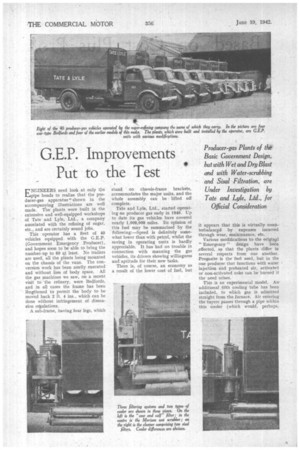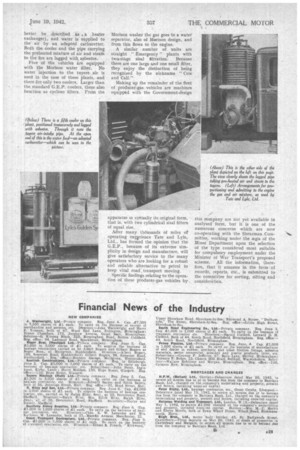G.E.P. Improvements
Page 24

Page 25

If you've noticed an error in this article please click here to report it so we can fix it.
Put to •the Test
ENGINEERS need look at only the .1-14pipe bends to realize that the pnoducer-gas apparatus'"shown in the accompanying illustrations are well made. The plants were built in the extensive and well-equipped workshops of Tate and Lyle, Ltd., a company associated with the refining of sugar, etc., and are certainly sound jobs.
This operator has a fleet of 40 vehicles equipped with the G.E.P. (Government Emergency Producer), and hopes soon to be able to bring the number. up to 60 at least. No trailers are used, all the plants being mounted on the chassis of the vans. The conversion work has been neatly executed and without loss of body space. All the gas machines we saw, on a recent visit to ' the refinery, were Bedfords, and in all cases the frame has been lengthened to permit the body to be moved back 2 ft. 4 ins., which can be done without infringement of dimension regulations.
A sub-frame, having four legs, which stand on chassis-frame brackets, accommodates the major units, and the whole assembly can be lifted off complete.
Tate and Lyle, Ltd., started operating on producer gas early in 1940. Up to date its gas vehicles have covered nearly 1,000,000 miles. Its opinion of this fuel may be summarized by the following:—Speed is definitely somewhat lower than with petrol, whilst the saving in operating costs is hardly appreciable. It has had no trouble in connection with manning the gas vehicles, its drivers showing willingness and aptitude for their new tasks.
There is, of course, an economy as a result of the lower cost of fuel, but it appears that this is virtually counterbalancpd by expenses incurred through wear, maintenance, etc.
Various modifications to the origin0 " Emergency " design have been ,effected, so that the plants differ in several respects from one another. Progasite is the fuel used, but in the one producer that functions with water injection and preheated air, activated or non-activated coke can be burned if the need arises.
This is an experimental model. Anadditional fifth cooling tube has been included, to which gas is admitted Straight from the furnace. Air entering the tuyere passes through a pipe within this cooler (which would, perhaps, better be described as . a heater exchanger), and water is supplied to the air by an adapted carburetter. Both the cooler and the pipe carrying the preheated mixture of air and steam to the fire are lagged with asbestos..
Five of the ehicles are equipped with the Morison water filter. No water injection to the tuyere air is used in the case of these plants, and there ire only two coolers. Larger than the standard G.E.P. coolers, these also function as cyclone filters. From the
Morison washer the gas goes to a water separator, also of Morison design, and from this flows to the engine.
A similar number of units are straight " Emergency " plants with two.-stage sisal Altration. Because there are one large and one small filter, they enjoy the distinction of being recognized by the nickname " Cow and Calf."
Making up the remainder of the fleet of producer-gas vehicles are machines equipped with the Government-design apparatus in virtually its original form, that is, with two cylindrical sisal filters of equal size.
After many thOusands of miles of operating exwrience Tate and Lyle. Ltd., has formed the opinion that the G.E.P., because of its extreme simplicity in design and manufacture, will give satisfactory service to the many . operators who are looking for a robust and reliable alternative to petrol to keep vital road , transport moving. Specific findings relating to the operation of these producer-gas vehicles by. this company are not yet available in analysed form, but it is one of the numerous concerns which are now co-operating with the Shearman ,Coinmittee, working under the aegis of the Mines Department upon the selection of the type considered most suitable for compulsory employment under tho Minister of War Transport's proposed scheme. All the information, therefore, that it amasses in the form of records, reports, etc., is submitted to the committee for sorting, sifting and consideration.




















































